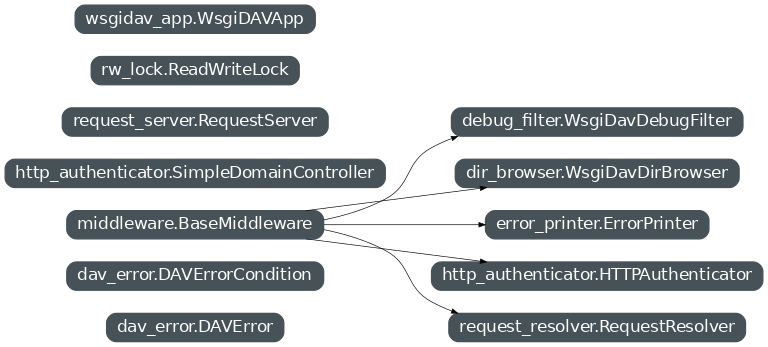Attention
You are looking at outdated documentation for version 2.x. A newer version is available.
Architecture¶
This document gives a brief introduction to the WsgiDAV application package (targeted to developers).
WSGI Application Stack¶
WsgiDAV is a WSGI application.
WSGI <http://www.python.org/peps/pep-0333.html> stands for Web Server Gateway Interface, a proposed standard interface between web servers and Python web applications or frameworks, to promote web application portability across a variety of web servers. If you are unfamiliar with WSGI, do take a moment to read the PEP.
As most WSGI applications, WsgiDAV consists of middleware which serve as pre-filters and post-processors, and the actual application.
WsgiDAV implements this WSGI application stack:
<Request>
|
<Server> -> wsgidav_app.WsgiDavApp (container)
|
+-> debug_filter.WsgiDavDebugFilter (middleware, optional)
|
error_printer.ErrorPrinter (middleware)
|
http_authenticator.HTTPAuthenticator (middleware)
| \- Uses a domain controller object
|
dir_browser.WsgiDavDirBrowser (middleware, optional)
|
request_resolver.RequestResolver (middleware)
|
*-> request_server.RequestServer (application)
\- Uses a DAVProvider object
\- Uses a lock manager object
and a property manager object
Note
This is the default stack. Middleware applications and order can be configured using
middleware_stack option. You can write your own or extend existing
middleware and place it on middleware stack.
See the following sections for details.
Building Blocks¶
DAV Providers¶

DAV providers are abstractions layers that are used by the
RequestServer to access and manipulate DAV resources.
All DAV providers must implement a common interface. This is usually done by
deriving from the abstract base class DAVProvider.
WsgiDAV comes with a DAV provider for file systems, called
FilesystemProvider. That is why WsgiDAV is a WebDAV file
server out-of-the-box.
There are also a few other modules that may serve as examples on how to plug-in your own custom DAV providers (see also Writing Custom Providers).
Property Managers¶

DAV providers may use a property manager to support persistence for dead properties.
WsgiDAV comes with two default implementations, one based on a in-memory dictionary, and a persistent one based on shelve:
property_manager.PropertyManager
property_manager.ShelvePropertyManager
PropertyManager is used by default,
but ShelvePropertyManager can be enabled by
uncommenting two lines in the configuration file.
In addition, this may be replaced by a custom version, as long as the required interface is implemented.
Lock Managers¶

DAV providers may use a lock manager to support exclusive and shared write locking.
WsgiDAV comes with two default implementations, one based on a in-memory dictionary, and a persistent one based on shelve:
lock_manager.LockManager
lock_manager.ShelveLockManager
LockManager is used by default, but
ShelveLockManager can be
enabled by uncommenting two lines in the configuration file.
In addition, this may be replaced by a custom version, as long as the required interface is implemented.
Domain Controllers¶

A domain controller provides user/password checking for a realm to the HTTPAuthenticator.
WsgiDAV comes with a default implementation that reads a user/password list from the config file.
However, this may be replaced by a custom version, as long as the required interface is implemented.
~wsgidav.addons.nt_domain_controller is an example for such an extension.
WsgiDAVDomainController- Default implementation of a domain controller as used by
HTTPAuthenticator.
Applications¶

WsgiDavApp¶
WsgiDavDebugFilter¶
ErrorPrinter¶
Middleware error_printer.ErrorPrinter
Handle DAV exceptions and internal errors.
- On init:
- Store error handling preferences.
- For every request:
- Pass the request to the next middleware. If a DAV exception occurs, log info, then pass it on. Internal exceptions are converted to HTTP_INTERNAL_ERRORs.
HTTPAuthenticator¶
Middleware http_authenticator.HTTPAuthenticator
Uses a domain controller to establish HTTP authentication.
- On init:
- Store the domain controller object that is used for authentication.
- For every request:
if authentication is required and user is not logged in: return authentication response.
Else set these values:
``environ['httpauthentication.realm']`` ``environ['httpauthentication.username']``
WsgiDavDirBrowser¶
Middleware dir_browser.WsgiDavDirBrowser
Handles GET requests on collections to display a HTML directory listing.
On init:
For every request:
- If path maps to a collection:
- Render collection members as directory (HTML table).
RequestResolver¶
Middleware request_resolver.RequestResolver
Find the mapped DAV-Provider, create a new RequestServer instance, and dispatch
the request.
On init:
Store URL-to-DAV-Provider mapping.
For every request:
Setup
environ["SCRIPT_NAME"]to request realm and andenviron["PATH_INFO"]to resource path.Then find the registered DAV-Provider for this realm, create a new
RequestServerinstance, and pass the request to it.Note: The OPTIONS method for ‘*’ is handled directly.
RequestServer¶
Application request_server.RequestServer
Handles one single WebDAV request.
On init:
Store a reference to the DAV-Provider object.
For every request:
Handle one single WebDAV method (PROPFIND, PROPPATCH, LOCK, …) using a DAV-Provider instance. Then return the response body or raise an DAVError.
Note: this object only handles one single request.